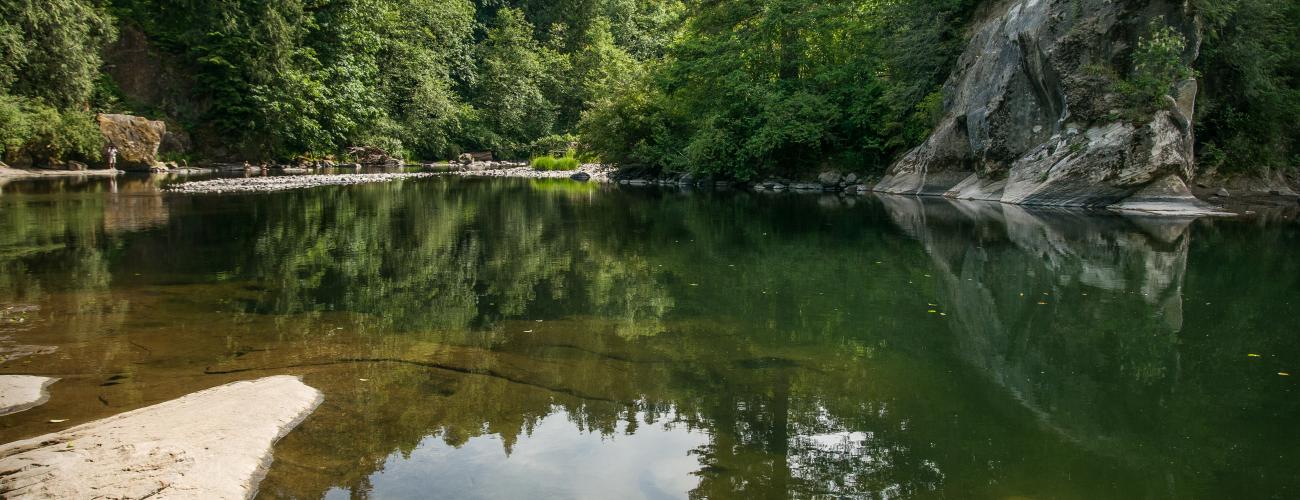Kanaskat-Palmer State Park History
Kanaskat-Palmer State Park borders the Green River at the upper end of the Green River Gorge, a unique place where sandstone bedrock, covered by glacial deposits in most of the Puget Sound lowlands, is revealed by the downcutting of the river through the formation. Seams of coal interwoven with the sandstone fueled a local mining industry in the early 20th century.
Indigenous Lands
Kanaskat-Palmer State Park lies within the traditional territories of Coast Salish Indigenous people whose present-day descendants include members of the Muckleshoot Indian Tribe, Snoqualmie Indian Tribe, and Confederated Tribes and Bands of the Yakama Nation. Since time immemorial the Green River watershed has provided habitat for a diverse community of life that forms the basis of their cultures, especially around the harvest, preservation and stewardship of salmon in the Green River. Traditionally, resource gathering was performed with temporary summer residences at specific resource sites and larger permanent winter villages in locations protected from cold-season weather.
Treaties and Conflict
The Oregon Treaty between the United State and Great Britain in 1846 established the border between the two countries’ colonial administration at the 49th parallel, putting the lands making up today’s Kanaskat-Palmer State Park under American jurisdiction. Passage of the Donation Land Claim Act of 1850 by the US Congress encouraged Americans to claim land in the territory.
Local tribes ceded ownership of the area to the US federal government under duress in the Treaty of Medicine Creek in 1854. Poor communication at the treaty council and provocations by territorial officials and local land claimants afterwards led to armed conflict between allied tribes against US government forces and volunteer militias. Kanaskat, a leader of the Klickitat people, joined Leschi (Nisqually) and Kitsap (Muckleshoot) in leading the resistance. Kanaskat was summarily executed in 1856.
Indian Agent Michael Simmons ordered all noncombatant tribal members to an internment camp on Fox Island in November 1855. The Medicine Creek Treaty was renegotiated at the Fox Island Council on August 5, 1856. The parties reached an agreement to relocate and enlarge the Nisqually and Puyallup Reservations and added the Muckleshoot Reservation, located about ten miles west of today’s Kanaskat-Palmer State Park. The treaty revisions were approved by President Franklin Pierce on January 20, 1857. As pressure from incoming settlers increased, Indigenous people moved from traditional village sites throughout the Green River watershed to the Muckleshoot Reservation.
After government land surveys were completed in 1881, the land in today’s Kanaskat-Palmer State Park passed into private ownership in 1891 and 1892 as a Homestead Entry patent to Edward Haydon and Cash Entry patents to Harold Evans and William Weitzel.
The Northern Pacific Railway (NP) route through Stampede Pass to its terminus at Tacoma was completed in 1886. A telegraph station on the line adjacent to today’s park was named for George L. Palmer, a timber cruiser for the company.
When the NP finished a branch line from the Palmer station to Auburn in 1900, the line included a water-stop for steam-powered trains that was designated as the Kanaskat station.
Becoming a State Park
Conservationist Wolf Bauer was a mountain climber, kayaker and retired engineer who had previously launched America’s first mountain search and rescue organization in Seattle. In 1966 he authored and photographed a widely read article in the Seattle Times Sunday Magazine that showed the Green River Gorge as a natural marvel. Bauer passionately made the case for protecting what he called “A Ribbon of Wilderness in Our Midst.” On April 24, 1969, Governor Daniel J. Evans approved Engrossed Senate Bill 514, stating that “A twelve mile strip [of the Green River Gorge]…needs to be acquired and developed as a conservation area to preserve this unique area for the recreational needs of the region.”
The Washington State Parks and Recreation Commission (WSPRC) acquired several parcels beginning in 1973 and developed the park campground and day-use facilities. Kanaskat-Palmer State Park was dedicated in September 1983.
Sharing the histories of Washington’s state parks is an ongoing project. Learn more here.

